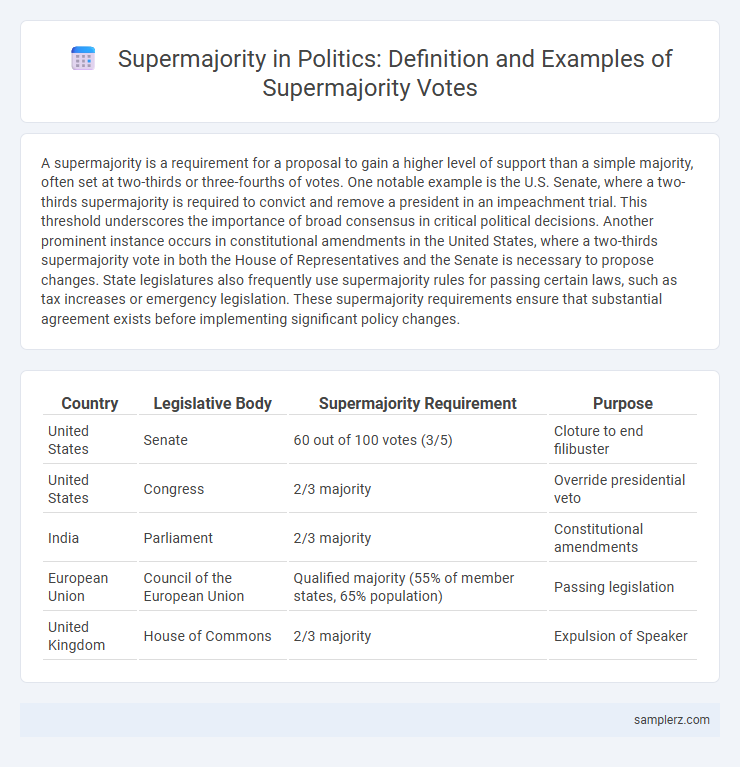A supermajority is a requirement for a proposal to gain a higher level of support than a simple majority, often set at two-thirds or three-fourths of votes. One notable example is the U.S. Senate, where a two-thirds supermajority is required to convict and remove a president in an impeachment trial. This threshold underscores the importance of broad consensus in critical political decisions. Another prominent instance occurs in constitutional amendments in the United States, where a two-thirds supermajority vote in both the House of Representatives and the Senate is necessary to propose changes. State legislatures also frequently use supermajority rules for passing certain laws, such as tax increases or emergency legislation. These supermajority requirements ensure that substantial agreement exists before implementing significant policy changes.
Table of Comparison
| Country | Legislative Body | Supermajority Requirement | Purpose |
|---|---|---|---|
| United States | Senate | 60 out of 100 votes (3/5) | Cloture to end filibuster |
| United States | Congress | 2/3 majority | Override presidential veto |
| India | Parliament | 2/3 majority | Constitutional amendments |
| European Union | Council of the European Union | Qualified majority (55% of member states, 65% population) | Passing legislation |
| United Kingdom | House of Commons | 2/3 majority | Expulsion of Speaker |
Defining Supermajority: What Does It Mean in Politics?
A supermajority in politics typically requires a higher threshold than a simple majority, often two-thirds or three-fifths of votes, to pass significant legislation or constitutional amendments. This elevated requirement ensures broader consensus, preventing drastic changes based on slim majorities. Examples include the U.S. Senate's two-thirds vote needed for treaty ratification or impeachment conviction.
Historical Examples of Supermajority Votes Worldwide
The 1964 U.S. Civil Rights Act passed with a supermajority of 73-27 in the Senate, demonstrating bipartisan commitment to ending segregation. In India, the 1975 declaration of Emergency received a two-thirds majority in Parliament, highlighting a controversial use of supermajority power. The European Union's Lisbon Treaty was ratified by supermajority votes across member states, solidifying key governance reforms.
Supermajority in the U.S. Senate: Key Cases
A supermajority in the U.S. Senate requires at least 60 out of 100 votes to overcome a filibuster, significantly impacting legislative outcomes. Key cases include the confirmation of Supreme Court justices and major treaties, where bipartisan support is essential. This threshold shapes Senate negotiations and influences policy stability across administrations.
Constitutional Amendments: Supermajority Requirements Explained
A supermajority is often required in constitutional amendments to ensure broad consensus, typically necessitating a two-thirds or three-fourths majority vote in legislative bodies. For instance, amending the U.S. Constitution mandates a two-thirds vote in both the House of Representatives and the Senate, followed by ratification from three-fourths of the state legislatures. This supermajority threshold prevents significant changes without substantial agreement, preserving the stability and integrity of the constitution.
Notable Supermajority Decisions in the European Parliament
The European Parliament has witnessed notable supermajority decisions, such as the 2019 adoption of the European Green Deal where over 70% of MEPs voted in favor, reflecting strong cross-party support for climate action. Another example includes the 2020 resolution condemning human rights violations in Belarus, secured with a two-thirds majority, underscoring the Parliament's commitment to democratic values. These instances highlight the strategic use of supermajorities to reinforce legitimacy and foster consensus on critical political issues within the EU legislative process.
Supermajority and Impeachment Proceedings: Famous Examples
A supermajority vote, often requiring two-thirds or three-fourths approval, is critical in impeachment proceedings as seen in the U.S. House of Representatives during the impeachments of Presidents Andrew Johnson, Bill Clinton, and Donald Trump. In each case, a supermajority in the Senate is required to convict and remove the president from office, a threshold intentionally set to ensure broad bipartisan consensus. This high voting bar underscores the political and legal gravity of impeachment as a constitutional mechanism.
Supermajority’s Role in Treaty Ratification
A supermajority requirement, often two-thirds of the Senate, is pivotal in treaty ratification to ensure broad bipartisan support and legitimacy in international agreements. This heightened threshold prevents narrow majorities from committing the nation to binding obligations, fostering stability in foreign policy. For example, the U.S. Constitution mandates a two-thirds Senate vote to ratify treaties, emphasizing the supermajority's critical role in balancing executive power and legislative oversight.
Case Study: Supermajority in United Nations Voting
The United Nations often requires a supermajority vote for key decisions in the Security Council, such as the adoption of resolutions, which demands at least nine out of fifteen affirmative votes including all five permanent members' approval. This veto power held by China, France, Russia, the United Kingdom, and the United States exemplifies a supermajority mechanism ensuring broad consensus. The use of supermajority in the UN promotes international cooperation while preventing unilateral actions by any single country.
The Impact of Supermajority Requirements on Legislation
Supermajority requirements, such as the two-thirds vote needed in the U.S. Senate to invoke cloture and end a filibuster, significantly influence legislative outcomes by elevating the threshold for passing bills. This higher voting bar often leads to increased bipartisan negotiation but can also result in legislative gridlock, particularly on contentious issues like tax reforms or constitutional amendments. The impact of supermajority rules is evident in how they empower minority factions, shaping policy dynamics and the pace of lawmaking within democratic institutions.
Challenges and Criticisms of Supermajority Votes in Democracy
Supermajority votes, such as the two-thirds requirement for constitutional amendments in the U.S. Senate, often face criticism for enabling minority obstruction and legislative gridlock. These high thresholds can hinder timely policy responses and dilute majority rule, raising concerns about democratic efficiency and accountability. Critics argue that supermajority rules may empower a small faction to stall reforms, undermining representative governance.

example of supermajority in vote Infographic
 samplerz.com
samplerz.com